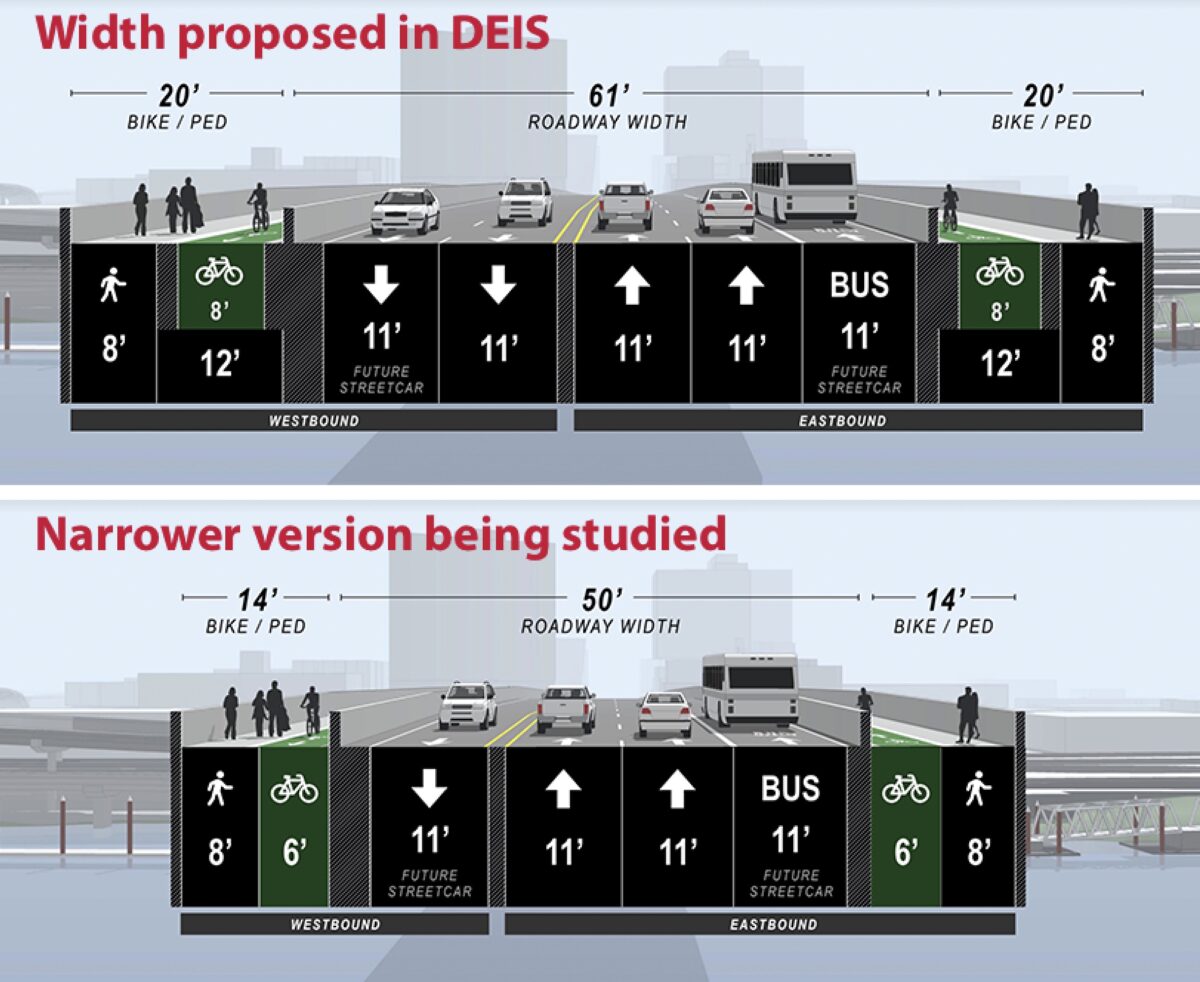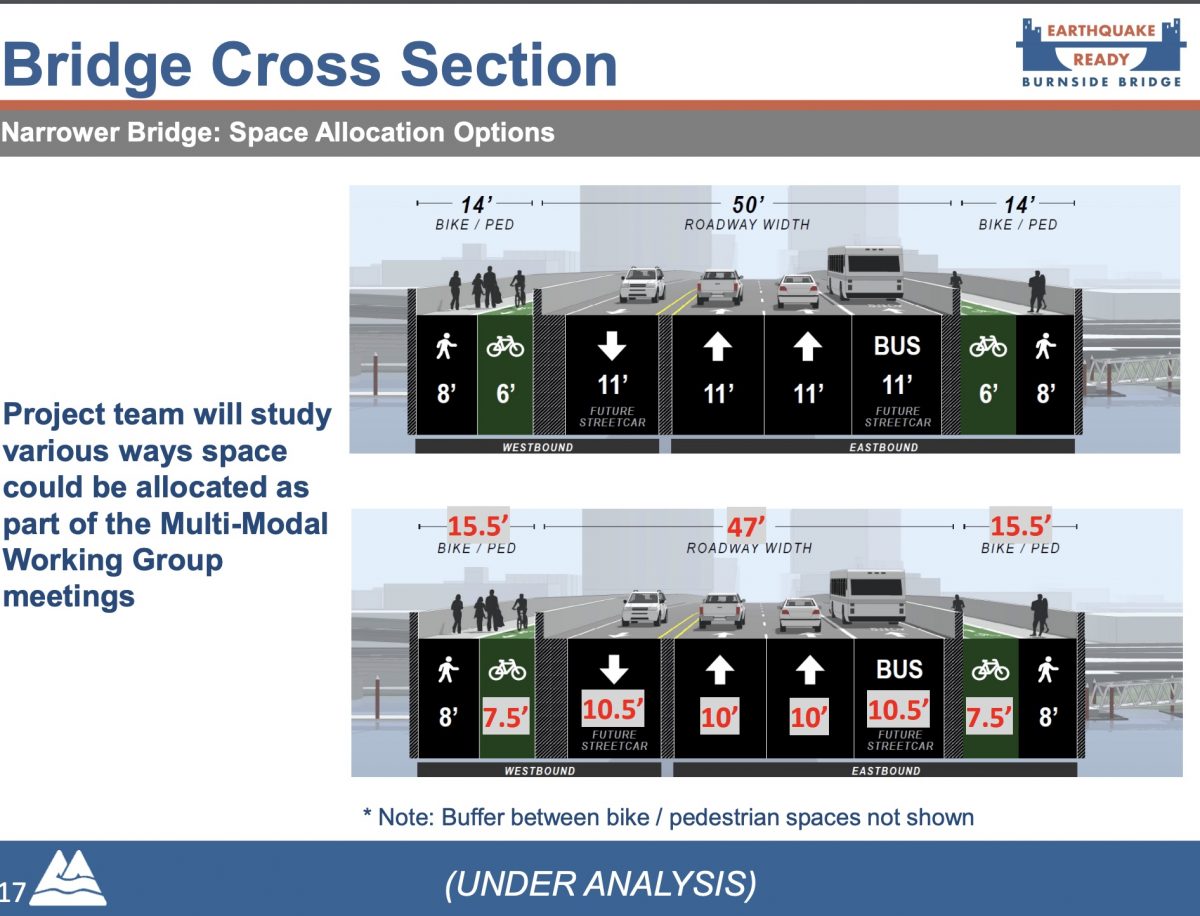Cycling News & Blog Articles
Budget cuts to Burnside Bridge project could mean narrower bike lanes, no Esplanade ramp
Multnomah County is looking to shave about $180 million off the cost of the new Burnside Bridge. A smaller budget for the Earthquake Ready Burnside Bridge project could lead to a narrower cross-section that has less space for walk and biking. Another potential cut could be the cycling ramp from the Eastbank Esplanade up to the new bridge deck.
The County announced at a project task force meeting on Monday night that they’ve begun a series of cost-saving studies to determine which course of action will save the most money and have the least negative impacts for users. The budget tinkering is being done to make the project more competitive for looming federal funding opportunities, made even more crucial to the county since the $150 million they hoped to secure from the Metro transportation funding measure failed to come through.
With the release of the Draft Environmental Impact Statement back in February, Multnomah County was ready to move into awarding construction contracts this coming winter and start construction on the $900 million project in 2024. Now they’ll push the timeline back six to 12 months to do the cost studies and develop a Supplemental Environmental Impact Statement based on what they find. With just $300 million set aside for the project so far, the County needs to win a federal grant from the Biden Administration and they hope bringing the cost down will make that more likely.
Advertisement
The impact of all this to bicycle riders could be significant. According to County spokesperson Mike Pullen, the largest cost savings — estimated to be $140 to $165 million — would come from narrowing the overall width of the bridge from 101-feet wide to 78-feet wide. They would do this by eliminating one of the general purpose lanes and shaving several feet off the bicycling/walking lanes. In the Draft EIS, the bike path and sidewalk was up to 20 feet wide on each side, or about eight feet each not including buffers and shy distance. The County says a narrowed version would reduce the cycling and walking facility to “at least 14 feet on each side”.
As you can see in the graphics above, the driving space on the bridge would be reduced by 11-feet on a narrower bridge. The 14-foot bike/walk space would be divided with eight feet going to the sidewalk and up to seven and-a-half feet going to a bike lane. The final width allocations would be decided later. It’s important to note that the existing width of the bike/walk space on the Burnside Bridge is 12.8 feet — nearly the same as what the County will consider for the new bridge.
Pullen said the path would feel similar to the Tilikum Crossing Bridge. While the bike/walk space would be less than the County hoped for at the outset of the project, Pullen said they remain committed to physical separation. “The crash worthy barrier between the bike/ped facility and the traffic lanes is not something we would sacrifice. We will not engineer that out.”

One second thought, maybe not.
One thing that might be engineered out is a ramp from the Esplanade up to the new bridge. As we shared in October 2020, project designers were working on a ramp similar to the one on the east end of the Steel Bridge. Now they are considering the “least cost options” for both the east side connection to the Esplanade and for the west side connection to the MAX light rail station at Skidmore Fountain. Pullen confirmed that bike ramps could be cut, but the cost studies could still leave the door open. “We’re committed to funding an ADA-compliant connection and our decision will be the lowest cost option — that could be elevators and stairs, or elevator and a ramp.” Pullen left the door open to a financial partnership with the City of Portland and/or TriMet that would ensure ramps stay in the plans.
The next big opportunity for the public to weigh in on these changes will be February 2022 when cost analysis will be complete and the SEIS comes out for review. Stay tuned.
— Jonathan Maus: (503) 706-8804, @jonathan_maus on Twitter and This email address is being protected from spambots. You need JavaScript enabled to view it.
— Get our headlines delivered to your inbox.
— Support this independent community media outlet with a one-time contribution or monthly subscription.




